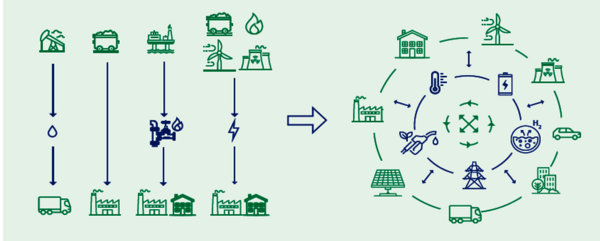
There are plans to build more wind farms in the North Sea, bringing the total amount of GW’s generated up to over 50. In the Netherlands households will sooner or later have to pay to offload their excess solar energy onto the grid. Because the grid can’t handle the extra load. So, the question is: how to distribute all that extra energy from the wind farms? At the same time, companies have a hard time finding new locations for offices and warehouses. Because energy suppliers can’t guarantee the reliable delivery of electricity.
Where’s the system?
A remarkable recent development is the rising number of battery-suppliers asking to be ‘hooked up’ to electricity grids. Their batteries can then store and redistribute energy when supply is high and redistribute it when demand surpasses supply, like at night. This is an example of thinking in systems, be it one on a small scale. It only focusses on electricity.
From electricity to hydrogen and back
But in the energy transition we also must deal with gas. It has been the go-to fuel for high temperature processes and heating in the past decades. Electricity can only replace it partially. The most likely candidate to do so completely is hydrogen. Modern system for transporting gas can be upgraded relatively easily and widespread distribution of hydrogen has a big system-bonus.
Hydrogen creation requires a large and steady supply of energy. The surplus energy from the upcoming windfarms could power the electrolyzers that extract the hydrogen. The hydrogen produced could then be distributed using pipelines and used to produce electricity locally. This would then also fix the local electricity ‘shortage’.
The heat battery
Closer to our private homes we find another example of thinking beyond conventions. In older houses – those built before 1980 and especially those built before 1950 – insulation ranges from moderate quality to completely lacking. The conventional approach is to insulate every part of these buildings. But that is very expensive and typically the residents of these houses can’t afford these major improvements.
Together with TNO, Olaf Adan, lecturer at TU/e developed the Heat Battery. It is a device which essentially revolves around a relatively old thermochemical principle: the reaction of a salt hydrate with water vapor. The salt crystals absorb the water, grow larger, and in the process, heat is released. To recharge this battery, the salt hydrate is heated. Combined with a form of renewable energy, like solar energy, this battery could eliminate or mitigate the need for very thorough insulation and keep living affordable for the residents of older houses.
Creativity is the key
System thinking requires governments and other parties to look at the bigger picture and work together. No single type of energy will help us complete the energy transition. But we also need creativity to come up with alternative solutions. EIRES, the Eindhoven Institute For Renewable Energy Systems support the development of innovative types of energy and fuels. The metal fuel project, where metal particles charged with energy, are used to power heavy motors and machines is a good example.
Fundamental insights
EIRES’ managing director, Mark Bonenschansker, spoke out in favor of thinking in systems. In his own words: “The energy transition is the greatest challenge of our generation. To tackle it we need to acquire fundamental insights in the production, transport, use, and storage of our energy - and mobilize our industry.”
Cooperation is in TU/e’s dna. Since its founding it worked with companies close by and far away to develop groundbreaking technology and solutions to society’s questions. Now more than ever, the world needs engineers to speed up the energy transition.